Shark
| Sharks Temporal range: Possible records extend back to Early Permian
| |
|---|---|
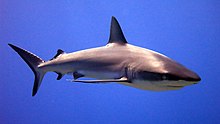
| |
| A grey reef shark (Carcharhinus amblyrhynchos) | |
| Scientific classification | |
| Domain: | Eukaryota |
| Kingdom: | Animalia |
| Phylum: | Chordata |
| Class: | Chondrichthyes |
| Subclass: | Elasmobranchii |
| Infraclass: | Euselachii
|
| Clade: | Neoselachii
|
| Subdivision: | Selachimorpha Nelson, 1984 |
| Orders | |
| Synonyms | |
| |
Sharks are a group of
Sharks range in size from the small
Several species are apex predators, which are organisms that are at the top of their food chain. Select examples include the tiger shark, blue shark, great white shark, mako shark, thresher shark, and hammerhead shark.
Sharks are caught by humans for shark meat or shark fin soup. Many shark populations are threatened by human activities. Since 1970, shark populations have been reduced by 71%, mostly from overfishing.[5]
Etymology
Until the 16th century,[6] sharks were known to mariners as "sea dogs".[7] This is still evidential in several species termed "dogfish," or the porbeagle.
The etymology of the word shark is uncertain, the most likely etymology states that the original sense of the word was that of "predator, one who preys on others" from the
A now disproven[original research?] theory is that it derives from the Yucatec Maya word xook (pronounced [ʃoːk]), meaning 'shark'.[9] Evidence for this etymology came from the Oxford English Dictionary, which notes shark first came into use after Sir John Hawkins' sailors exhibited one in London in 1569 and posted "sharke" to refer to the large sharks of the Caribbean Sea. However, the Middle English Dictionary records an isolated occurrence of the word shark (referring to a sea fish) in a letter written by Thomas Beckington in 1442, which rules out a New World etymology.[10][original research?]
Evolutionary history
Fossil record
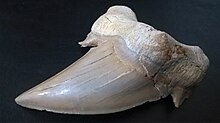
The oldest
Taxonomy
| ||||||||||||
| Phylogeny of living shark orders based on mitochondrial DNA[18] |
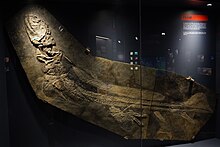
Sharks belong to the
The superorder Selachimorpha is divided into Galea (or
There are more than 500 species of sharks split across thirteen orders, including several orders of sharks that have gone extinct:[22][23]
- blacktail reef, whitetip reef, and oceanic whitetip sharks (collectively called the requiem sharks) along with the houndsharks, catsharks, and hammerhead sharks. They are distinguished by an elongated snout and a nictitating membranewhich protects the eyes during an attack.
- Heterodontiformes: They are generally referred to as the bullhead or horn sharks.
- Hexanchiformes: Examples from this group include the cow sharks and frilled sharks, which somewhat resembles a marine snake.
- Lamniformes: They are commonly known as the mackerel sharks. They include the goblin shark, basking shark, megamouth shark, the thresher sharks, shortfin and longfin mako sharks, and great white shark. They are distinguished by their large jaws and ovoviviparous reproduction. The Lamniformes also include the extinct megalodon, Otodus megalodon.
- Orectolobiformes: They are commonly referred to as the carpet sharks, including zebra sharks, nurse sharks, wobbegongs, and the whale shark.
- Pristiophoriformes: These are the sawsharks, with an elongated, toothed snout that they use for slashing their prey.
- Squaliformes: This group includes the dogfish sharks and roughsharks.
- stingrays and skates.
- Echinorhiniformes: This group includes the prickly shark and bramble shark. Phylogenetic placement of this group has been ambiguous in scientific studies.[24] They are sometimes given their own order, Echinorhiniformes.[23]
Anatomy

Teeth

Shark teeth are embedded in the
Tooth shape depends on the shark's diet: those that feed on
Skeleton
Shark skeletons are very different from those of bony fish and terrestrial vertebrates. Sharks and other cartilaginous fish (skates and rays) have skeletons made of cartilage and connective tissue. Cartilage is flexible and durable, yet is about half the normal density of bone. This reduces the skeleton's weight, saving energy.[27] Because sharks do not have rib cages, they can easily be crushed under their own weight on land.[28]
Jaw
The
Generally sharks have only one layer of tesserae, but the jaws of large specimens, such as the bull shark, tiger shark, and the great white shark, have two to three layers or more, depending on body size. The jaws of a large great white shark may have up to five layers.[27] In the rostrum (snout), the cartilage can be spongy and flexible to absorb the power of impacts.
Fins
Fin skeletons are elongated and supported with soft and unsegmented rays named ceratotrichia, filaments of elastic protein resembling the horny keratin in hair and feathers.[30] Most sharks have eight fins. Sharks can only drift away from objects directly in front of them because their fins do not allow them to move in the tail-first direction.[28]
Dermal denticles

Unlike bony fish, sharks have a complex dermal corset made of flexible collagenous fibers and arranged as a helical network surrounding their body. This works as an outer skeleton, providing attachment for their swimming muscles and thus saving energy.
Tails
Tiger sharks have a large upper lobe, which allows for slow cruising and sudden bursts of speed. The tiger shark must be able to twist and turn in the water easily when hunting to support its varied diet, whereas the porbeagle shark, which hunts schooling fish such as mackerel and herring, has a large lower lobe to help it keep pace with its fast-swimming prey.[36] Other tail adaptations help sharks catch prey more directly, such as the thresher shark's usage of its powerful, elongated upper lobe to stun fish and squid.
Physiology
Buoyancy
Unlike bony fish, sharks do not have gas-filled swim bladders for buoyancy. Instead, sharks rely on a large liver filled with oil that contains
Some sharks, if inverted or stroked on the nose, enter a natural state of
Respiration
Like other fish, sharks extract oxygen from seawater as it passes over their
The
Thermoregulation
Most sharks are "cold-blooded" or, more precisely,
Larger species, like the whale shark, are able to conserve their body heat through sheer size when they dive to colder depths, and the scalloped hammerhead close its mouth and gills when they dives to depths of around 800 metres, holding its breath till it reach warmer waters again.[43]
Osmoregulation
In contrast to bony fish, with the exception of the
Research in 1930 by
Digestion
Digestion can take a long time. The food moves from the mouth to a J-shaped stomach, where it is stored and initial digestion occurs.[49] Unwanted items may never get past the stomach, and instead the shark either vomits or turns its stomachs inside out and ejects unwanted items from its mouth.[50]
One of the biggest differences between the digestive systems of sharks and mammals is that sharks have much shorter intestines. This short length is achieved by the spiral valve with multiple turns within a single short section instead of a long tube-like intestine. The valve provides a long surface area, requiring food to circulate inside the short gut until fully digested, when remaining waste products pass into the cloaca.[49]
Fluorescence
A few sharks appear
Senses
Smell
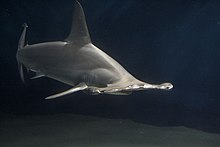
Sharks have keen
Sharks have the ability to determine the direction of a given scent based on the timing of scent detection in each nostril.[55] This is similar to the method mammals use to determine direction of sound.
They are more attracted to the chemicals found in the intestines of many species, and as a result often linger near or in
Sight

Shark
Hearing
Although it is hard to test the hearing of sharks, they may have a sharp
Electroreception
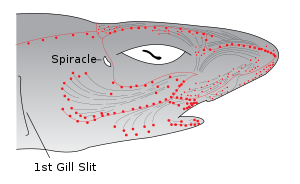
The ampullae of Lorenzini are the electroreceptor organs. They number in the hundreds to thousands. Sharks use the ampullae of Lorenzini to detect the electromagnetic fields that all living things produce.[62] This helps sharks (particularly the hammerhead shark) find prey. The shark has the greatest electrical sensitivity of any animal. Sharks find prey hidden in sand by detecting the electric fields they produce. Ocean currents moving in the magnetic field of the Earth also generate electric fields that sharks can use for orientation and possibly navigation.[63]
Lateral line
This system is found in most fish, including sharks. It is a tactile sensory system which allows the organism to detect water speed and pressure changes near by.[64] The main component of the system is the neuromast, a cell similar to hair cells present in the vertebrate ear that interact with the surrounding aquatic environment. This helps sharks distinguish between the currents around them, obstacles off on their periphery, and struggling prey out of visual view. The shark can sense frequencies in the range of 25 to 50 Hz.[65]
Life history
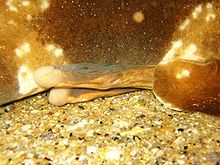
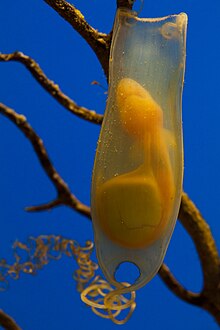
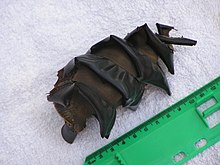
Shark lifespans vary by species. Most live 20 to 30 years. The
Reproduction
Unlike most
Sexual
Sharks practice
Mating has rarely been observed in sharks.[74] The smaller catsharks often mate with the male curling around the female. In less flexible species the two sharks swim parallel to each other while the male inserts a clasper into the female's oviduct. Females in many of the larger species have bite marks that appear to be a result of a male grasping them to maintain position during mating. The bite marks may also come from courtship behavior: the male may bite the female to show his interest. In some species, females have evolved thicker skin to withstand these bites.[73]
Asexual
There have been a number of documented cases in which a female shark who has not been in contact with a male has conceived a pup on her own through
Scientists say that asexual reproduction in the wild is rare, and probably a last-ditch effort to reproduce when a mate is not present. Asexual reproduction diminishes genetic diversity, which helps build defenses against threats to the species. Species that rely solely on it risk extinction. Asexual reproduction may have contributed to the blue shark's decline off the Irish coast.[77]
Brooding
Sharks display three ways to bear their young, varying by species,
Ovoviviparity
Most sharks are
Oviparity
Some species are
Viviparity
Viviparity is the gestation of young without the use of a traditional egg, and results in live birth.
Behavior
The classic view describes a solitary hunter, ranging the oceans in search of food. However, this applies to only a few species. Most live far more social, sedentary,
Sharks can be highly social, remaining in large schools. Sometimes more than 100 scalloped hammerheads congregate around seamounts and islands, e.g., in the Gulf of California.[37] Cross-species social hierarchies exist. For example, oceanic whitetip sharks dominate silky sharks of comparable size during feeding.[70]
When approached too closely some sharks perform a
Speed
In general, sharks swim ("cruise") at an average speed of 8 kilometres per hour (5.0 mph), but when feeding or attacking, the average shark can reach speeds upwards of 19 kilometres per hour (12 mph). The
Intelligence
Sharks possess brain-to-body mass ratios that are similar to mammals and birds,[87] and have exhibited apparent curiosity and behavior resembling play in the wild.[88][89]
There is evidence that juvenile lemon sharks can use observational learning in their investigation of novel objects in their environment.[90]
Sleep
All sharks need to keep water flowing over their gills in order for them to breathe; however, not all species need to be moving to do this. Those that are able to breathe while not swimming do so by using their spiracles to force water over their gills, thereby allowing them to extract oxygen from the water. It has been recorded that their eyes remain open while in this state and actively follow the movements of divers swimming around them[91] and as such they are not truly asleep.
Species that do need to swim continuously to breathe go through a process known as sleep swimming, in which the shark is essentially unconscious. It is known from experiments conducted on the spiny dogfish that its spinal cord, rather than its brain, coordinates swimming, so spiny dogfish can continue to swim while sleeping, and this also may be the case in larger shark species.[91] In 2016 a great white shark was captured on video for the first time in a state researchers believed was sleep swimming.[92]
Ecology
Feeding
Most sharks are
Other highly specialized feeders include cookiecutter sharks, which feed on flesh sliced out of other larger fish and marine mammals. Cookiecutter teeth are enormous compared to the animal's size. The lower teeth are particularly sharp. Although they have never been observed feeding, they are believed to latch onto their prey and use their thick lips to make a seal, twisting their bodies to rip off flesh.[37]
Some seabed–dwelling species are highly effective ambush predators.
Other sharks feed on squid or fish, which they swallow whole. The viper dogfish has teeth it can point outwards to strike and capture prey that it then swallows intact. The great white and other large predators either swallow small prey whole or take huge bites out of large animals. Thresher sharks use their long tails to stun shoaling fishes, and sawsharks either stir prey from the seabed or slash at swimming prey with their tooth-studded rostra.
Many sharks, including the
Range and habitat
Sharks are found in all seas. They generally do not live in fresh water, with a few exceptions such as the bull shark and the river shark which can swim both in seawater and freshwater.[96] Sharks are common down to depths of 2,000 metres (7,000 ft), and some live even deeper, but they are almost entirely absent below 3,000 metres (10,000 ft). The deepest confirmed report of a shark is a Portuguese dogfish at 3,700 metres (12,100 ft).[97]
Relationship with humans
Attacks
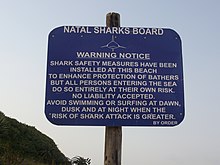
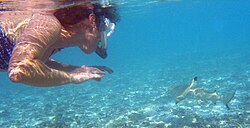
In 2006 the International Shark Attack File (ISAF) undertook an investigation into 96 alleged shark attacks, confirming 62 of them as unprovoked attacks and 16 as provoked attacks. The average number of fatalities worldwide per year between 2001 and 2006 from unprovoked shark attacks is 4.3.[98]
Contrary to popular belief, only a few sharks are dangerous to humans. Out of more than 470 species, only four have been involved in a significant number of fatal, unprovoked attacks on humans: the great white, oceanic whitetip, tiger, and bull sharks.[99][100] These sharks are large, powerful predators, and may sometimes attack and kill people. Despite being responsible for attacks on humans they have all been filmed without using a protective cage.[101]
The perception of sharks as dangerous animals has been popularized by publicity given to a few isolated unprovoked attacks, such as the Jersey Shore shark attacks of 1916, and through popular fictional works about shark attacks, such as the Jaws film series. Jaws author Peter Benchley, as well as Jaws director Steven Spielberg, later attempted to dispel the image of sharks as man-eating monsters.[102]
To help avoid an unprovoked attack, humans should not wear jewelry or metal that is shiny and refrain from splashing around too much.[103]
In general, sharks show little pattern of attacking humans specifically. Research indicates that when humans do become the object of a shark attack, it is possible that the shark has mistaken the human for species that are its normal prey, such as seals.[104][105] This was further proven in a recent study conducted by researchers at the California State University's Shark Lab. According to footage caught by the Lab's drones, juveniles swam right up to humans in the water without any bites incidents. The lab stated that the results showed that humans and sharks can co-exist in the water.[106]
In captivity

Until recently, only a few
Most species are not suitable for home aquaria, and not every species sold by pet stores are appropriate. Some species can flourish in home saltwater aquaria.[108] Uninformed or unscrupulous dealers sometimes sell juvenile sharks like the nurse shark, which upon reaching adulthood is far too large for typical home aquaria.[108] Public aquaria generally do not accept donated specimens that have outgrown their housing. Some owners have been tempted to release them.[108] Species appropriate to home aquaria represent considerable spatial and financial investments as they generally approach adult lengths of 3 feet (90 cm) and can live up to 25 years.[108]
In culture

In Hawaii
Sharks figure prominently in
In American Samoa
On the island of
In popular culture
In contrast to the complex portrayals by Hawaiians and other Pacific Islanders, the European and Western view of sharks has historically been mostly of fear and malevolence.
Popular misconceptions
A popular myth is that sharks are immune to disease and
Threats to sharks
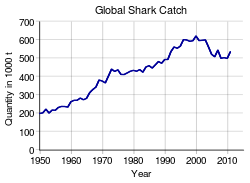
Fishery
In 2008, it was estimated that nearly 100 million sharks were being killed by people every year, due to commercial and recreational fishing.[124][125] In 2021, it was estimated that the population of oceanic sharks and rays had dropped by 71% over the previous half-century.[5]
Shark finning yields are estimated at 1.44 million metric tons (1.59 million short tons) for 2000, and 1.41 million metric tons (1.55 million short tons) for 2010. Based on an analysis of average shark weights, this translates into a total annual mortality estimate of about 100 million sharks in 2000, and about 97 million sharks in 2010, with a total range of possible values between 63 and 273 million sharks per year.[126][127] Sharks are a common seafood in many places, including Japan and Australia. In southern Australia, shark is commonly used in fish and chips,[128] in which fillets are battered and deep-fried or crumbed and grilled. In fish and chip shops, shark is called flake. In India, small sharks or baby sharks (called sora in Tamil language, Telugu language) are sold in local markets. Since the flesh is not developed, cooking the flesh breaks it into powder, which is then fried in oil and spices (called sora puttu/sora poratu). The soft bones can be easily chewed. They are considered a delicacy in coastal Tamil Nadu. Icelanders ferment Greenland sharks to produce a delicacy called hákarl.[129] During a four-year period from 1996 to 2000, an estimated 26 to 73 million sharks were killed and traded annually in commercial markets.[130]
Sharks are often killed for shark fin soup. Fishermen capture live sharks, fin them, and dump the finless animal back into the water. Shark finning involves removing the fin with a hot metal blade.[125] The resulting immobile shark soon dies from suffocation or predators.[131] Shark fin has become a major trade within black markets all over the world. Fins sell for about $300/lb in 2009.[132] Poachers illegally fin millions each year. Few governments enforce laws that protect them.[127] In 2010 Hawaii became the first U.S. state to prohibit the possession, sale, trade or distribution of shark fins.[133] From 1996 to 2000, an estimated 38 million sharks had been killed per year for harvesting shark fins.[130] It is estimated by TRAFFIC that over 14,000 tonnes of shark fins were exported into Singapore between 2005–2007 and 2012–2014.[134]
Shark fin soup is a
Sharks are also killed for
Sharks generally reach sexual maturity only after many years and produce few offspring in comparison to other harvested fish. Harvesting sharks before they reproduce severely impacts future populations. Capture induced premature birth and abortion (collectively called capture-induced parturition) occurs frequently in sharks/rays when fished.[72] Capture-induced parturition is rarely considered in fisheries management despite being shown to occur in at least 12% of live bearing sharks and rays (88 species to date).[72]
The majority of shark fisheries have little monitoring or management. The rise in demand for shark products increases pressure on fisheries.[38] Major declines in shark stocks have been recorded—some species have been depleted by over 90% over the past 20–30 years with population declines of 70% not unusual.[138] A study by the International Union for Conservation of Nature suggests that one quarter of all known species of sharks and rays are threatened by extinction and 25 species were classified as critically endangered.[139][140]
Shark culling
In 2014, a
From 1962 to the present,[146] the government of Queensland has targeted and killed sharks in large numbers by using drum lines, under a "shark control" program—this program has also inadvertently killed large numbers of other animals such as dolphins; it has also killed endangered hammerhead sharks.[147][148][149][150] Queensland's drum line program has been called "outdated, cruel and ineffective".[150] From 2001 to 2018, a total of 10,480 sharks were killed on lethal drum lines in Queensland, including in the Great Barrier Reef.[151] From 1962 to 2018, roughly 50,000 sharks were killed by Queensland authorities.[152]
The government of
Killing sharks negatively affects the marine ecosystem.[158][159] Jessica Morris of Humane Society International calls shark culling a "knee-jerk reaction" and says, "sharks are top order predators that play an important role in the functioning of marine ecosystems. We need them for healthy oceans."[160]
Other threats
Other threats include habitat alteration, damage and loss from coastal development, pollution and the impact of fisheries on the seabed and prey species.[164] The 2007 documentary Sharkwater exposed how sharks are being hunted to extinction.[165]
Conservation
In 1991, South Africa was the first country in the world to declare Great White sharks a legally protected species[166] (however, the KwaZulu-Natal Sharks Board is allowed to kill great white sharks in its "shark control" program in eastern South Africa).[156]
Intending to ban the practice of shark finning while at sea, the United States Congress passed the
In 2003, the European Union introduced a general shark finning ban for all vessels of all nationalities in Union waters and for all vessels flying a flag of one of its member states.[171] This prohibition was amended in June 2013 to close remaining loopholes.[172]
In 2009, the International Union for Conservation of Nature's IUCN Red List of Endangered Species named 64 species, one-third of all oceanic shark species, as being at risk of extinction due to fishing and shark finning.[173][174]
In 2010, the Convention on International Trade in Endangered Species (
In 2010, Greenpeace International added the
Under the auspices of the Convention on the Conservation of Migratory Species of Wild Animals (CMS), also known as the Bonn Convention, the Memorandum of Understanding on the Conservation of Migratory Sharks was concluded and came into effect in March 2010. It was the first global instrument concluded under CMS and aims at facilitating international coordination for the protection, conservation and management of migratory sharks, through multilateral, intergovernmental discussion and scientific research.
In July 2013, New York state, a major market and entry point for shark fins, banned the shark fin trade joining seven other states of the United States and the three Pacific U.S. territories in providing legal protection to sharks.[180]
In the United States, and as of January 16, 2019, 12 states including (Massachusetts, Maryland, Delaware, California, Illinois, Hawaii, Oregon, Nevada, Rhode Island, Washington, New York and Texas) along with 3 U.S. territories (American Samoa, Guam and the Northern Mariana Islands) have passed laws against the sale or possession of shark fins.[181][182]
Several regions now have
In April 2020 researchers reported to have traced the origins of
In July 2020 scientists reported results of a survey of 371 reefs in 58 nations estimating the conservation status of reef sharks globally. No sharks have been observed on almost 20% of the surveyed reefs and shark depletion was strongly associated with both socio-economic conditions and conservation measures.[188][189] Sharks are considered to be a vital part of the ocean ecosystem.
According to a 2021 study in
See also
References
Citations
- S2CID 9236223.
- S2CID 59224442.
- OCLC 39627633.
- ISBN 9780231035514.
- ^ a b Einhorn, Catrin (January 27, 2021). "Shark Populations Are Crashing, with a 'Very Small Window' to Avert Disaster". The New York Times. Retrieved January 31, 2021.
- ^ "Online Etymology Dictionary". Etymonline.com. Archived from the original on 2012-10-04. Retrieved 2013-09-07.
- ISBN 978-0-486-26487-5.
- ^ Online Etymology Dictionary, shark.
- ^ Jones, Tom. "The Xoc, the Sharke, and the Sea Dogs: An Historical Encounter". Archived from the original on 2008-11-21. Retrieved 2009-07-11.
- ^ "Shark". Middle English Dictionary. University of Michigan. Archived from the original on 2013-08-20. Retrieved 2014-02-02.
- S2CID 252570103.
- PMID 31575362.
- S2CID 229399689.
- ISBN 9781605357218.
- S2CID 84162775.
- S2CID 86232401.
- ^ Rees, J. A. N., and Underwood, C. J., 2008, Hybodont sharks of the English Bathonian and Callovian (Middle Jurassic): Palaeontology, v. 51, no. 1, p. 117–147.
- S2CID 3258973.
- ^ a b "Sharks (Chondrichthyes)". FAO. Archived from the original on 2008-08-02. Retrieved 2009-09-14.
- S2CID 16018112.
- S2CID 3258973.
- ^ a b "Compagno's FAO Species List - 1984". Elasmo.com. Archived from the original on 2010-05-28. Retrieved 2009-09-14.
- ^ a b "Echinorhiniformes". WoRMS. Retrieved 2022-01-29.
- PMID 26277575.
- ^ Martin, R. Aidan. "Teeth of the Skin". Archived from the original on 2007-10-12. Retrieved 2007-08-28.
- ^ ISBN 978-0-07-237716-3.
- ^ a b Martin, R. Aidan. "Skeleton in the Corset". ReefQuest Centre for Shark Research. Archived from the original on 2009-11-25. Retrieved 2009-08-21.
- ^ a b "A Shark's Skeleton & Organs". Archived from the original on August 5, 2010. Retrieved August 14, 2009.
- OCLC 39217534.
- ISBN 978-0-8018-6048-5.
- ^ a b Martin, R. Aidan. "The Importance of Being Cartilaginous". ReefQuest Centre for Shark Research. Archived from the original on 2009-02-27. Retrieved 2009-08-29.
- ^ Martin, R. Aidan. "Skin of the Teeth". Archived from the original on 2012-01-24. Retrieved 2007-08-28.
- ^ "Camouflage facts". National Geographic Society. 4 January 2019. Archived from the original on March 1, 2021. Retrieved 2021-11-25.
- PMID 33569175.
- ^ Michael, Bright. "Jaws: The Natural History of Sharks". Columbia University. Archived from the original on 2009-05-11. Retrieved 2009-08-29.
- OCLC 28965588.
- ^ OCLC 183136093.
- ^ a b Pratt, H. L. Jr; Gruber, S. H.; Taniuchi, T (1990). Elasmobranchs as living resources: Advances in the biology, ecology, systematics, and the status of the fisheries. NOAA Tech Rept.
- ^ Bennetta, William J. (1996). "Deep Breathing". Archived from the original on 2007-08-14. Retrieved 2007-08-28.
- ^ "Do sharks sleep". Flmnh.ufl.edu. 2017-05-02. Archived from the original on 2010-09-18.
- ^ "SHARKS & RAYS, SeaWorld/Busch Gardens ANIMALS, CIRCULATORY SYSTEM". Busch Entertainment Corporation. Archived from the original on 2009-04-24. Retrieved 2009-09-03.
- ^ Martin, R. Aidan (April 1992). "Fire in the Belly of the Beast". ReefQuest Centre for Shark Research. Archived from the original on 2009-09-17. Retrieved 2009-08-21.
- S2CID 258639015– via www.nature.com.
- S2CID 38498079.
- ^ "Sharkproject". Archived from the original on 4 March 2016. Retrieved 31 December 2016.
- ^ Musick, John A. (2005). "Management techniques for elasmobranch fisheries: 14. Shark Utilization". FAO: Fisheries and Aquaculture Department. Archived from the original on 2011-07-22. Retrieved 2008-03-16.
- ^ Batten, Thomas. "MAKO SHARK Isurus oxyrinchus". Delaware Sea Grant, University of Delaware. Archived from the original on 2008-03-11. Retrieved 2008-03-16.
- PMID 28066051.
- ^ a b Martin, R. Aidan. "No Guts, No Glory". ReefQuest Centre for Shark Research. Archived from the original on 2009-08-11. Retrieved 2009-08-22.
- ^ Potenza, Alessandra (20 June 2017). "Sharks literally puke their guts out—here's why". The Verge. Archived from the original on 19 June 2017. Retrieved 21 June 2017.
- PMID 31402257.
- ^ Martin, R. Aidan. "Smell and Taste". ReefQuest Centre for Shark Research. Archived from the original on 2009-12-07. Retrieved 2009-08-21.
- ^ S2CID 2829434.
- S2CID 2151639.
- ^ The Function of Bilateral Odor Arrival Time Differences in Olfactory Orientation of Sharks Archived 2012-03-08 at the Wayback Machine, Jayne M. Gardiner, Jelle Atema, Current Biology - 13 July 2010 (Vol. 20, Issue 13, pp. 1187–1191)
- ^ Martin, R. Aidan. "Vision and a Carpet of Light". ReefQuest Centre for Shark Research. Archived from the original on 2009-04-29. Retrieved 2009-08-22.
- ^ "Sharks are colour-blind, new study finds". Archived from the original on 2011-01-24. Retrieved 2011-02-03.
- ^ Gill, Victoria (2011-01-18). "Sharks are probably colour-blind". BBC News. Archived from the original on 2011-01-19. Retrieved 2011-01-19.
- S2CID 30148811.
- ^ Martin, R. Aidan. "Hearing and Vibration Detection". Archived from the original on 2008-05-01. Retrieved 2008-06-01.
- ^ Casper, B. M. (2006). The hearing abilities of elasmobranch fishes (PhD dissertation). University of South Florida. p. 16.
- PMID 7134985.
- PMID 16849172.
- PMID 21392273.
- ^ Popper, A. N.; C. Platt (1993). "Inner ear and lateral line". The Physiology of Fishes (1st ed).
- ^ "Mote Marine Laboratory, "Shark Notes"". Mote.org. Archived from the original on 2012-01-24. Retrieved 2012-08-27.
- ^ "Florida Museum of Natural History Ichthyology Department, "National Shark Research Consortium–Shark Basics"". Archived from the original on September 4, 2007.
- S2CID 206647043.
- from the original on 12 August 2016. Retrieved 11 August 2016.
- ^ OCLC 156157504.
- ^ Gruber, Samuel H. (February 21, 2000). "LIFE STYLE OF SHARKS". Archived from the original on July 27, 2011. Retrieved June 20, 2010.
- ^ S2CID 90834034. Archived from the originalon 2019-02-23. Retrieved 2018-11-24.
- ^ a b Martin, R. Aidan. "Why Do Sharks Have Two Penises?". ReefQuest Centre for Shark Research. Archived from the original on 2009-08-28. Retrieved 2009-08-22.
- ^ "How Do Sharks Mate? - Center For Ocean Life". Center For Ocean Life. Archived from the original on 2018-09-06. Retrieved 2018-09-09.
- PMID 17519185.
- ^ In shark tank, an asexual birth Archived 2009-07-09 at the Wayback Machine, Boston Globe, 10 Oct. 2008
- ^ Fountain, Henry (2007-05-23). "Female sharks reproduce without male DNA, scientists say". The New York Times. Archived from the original on 2009-04-17. Retrieved 2007-11-13.
- ^ a b c d "SHARKS & RAYS, SeaWorld/Busch Gardens ANIMALS, BIRTH & CARE OF YOUNG". Busch Entertainment Corporation. Archived from the original on 2013-08-03. Retrieved 2009-09-03.
- S2CID 90834034. Archived from the originalon 2019-02-23. Retrieved 2018-11-24.
- Napier University. Archived from the originalon 2003-08-23. Retrieved 2006-09-12.
- ^ a b c Carrier, J.C; Musick, J.A.; Heithaus, M.R. (2012). Biology of Sharks and Their Relatives: Second Edition. Taylor & Francis Group.
- ^ The truth about sharks: Far from being 'killing machines', they have personalities, best friends and an exceptional capacity for learning Archived 2015-07-03 at the Wayback Machine (2014-11-28), The Independent
- ^ Ravilious, Kate (2005-10-07). "Scientists track shark's 12,000 mile round-trip". Guardian Unlimited. London. Retrieved 2006-09-17.
- JSTOR 1442360.
- ^ Reefquest Center for Shark Research. What's the Speediest Marine Creature? Archived 2009-04-14 at the Wayback Machine
- ^ The secret life of sharks Archived 2012-04-05 at the Wayback Machine, Maria Moscaritolo, The Adelaide Advertiser, 3 March 2012.
- ISBN 978-0-521-83522-0.
- ^ "Is the White Shark Intelligent". ReefQuest Centre for Shark Research. Archived from the original on 2012-01-24. Retrieved 2006-08-07.
- ^ "Biology of the Porbeagle". ReefQuest Centre for Shark Research. Archived from the original on 2013-02-17. Retrieved 2006-08-07.
- S2CID 351363. Archived from the originalon 2019-04-27. Retrieved 2019-09-05.
- ^ a b "How Do Sharks Swim When Asleep?". ReefQuest Centre for Shark Research. Archived from the original on 2012-01-24. Retrieved 2006-08-07.
- ^ "Great White Shark Caught On Camera Napping For The First Time". NPR. 6 July 2016. Retrieved 16 December 2019.
- ^ a b Martin, R. Aidan. "Building a Better Mouth Trap". ReefQuest Centre for Shark Research. Archived from the original on 2012-01-24. Retrieved 2009-08-22.
- ^ Martin, R. Aidan. "Order Orectolobiformes: Carpet Sharks—39 species". ReefQuest Centre for Shark Research. Archived from the original on 2009-04-29. Retrieved 2009-08-29.
- ^ Stevens 1987
- ^ "Carcharhinus leucas". University of Michigan Museum of Zoology, Animal Diversity Web. Archived from the original on 2011-06-05. Retrieved 2006-09-08.
- PMID 16777734.
- ^ "Worldwide shark attack summary". International Shark Attack File. Archived from the original on 2007-08-18. Retrieved 2007-08-28.
- ^ "Statistics on Attacking Species of Shark". ISAF. Archived from the original on 2009-07-24. Retrieved 2006-09-12.
- ^ "Biology of sharks and rays". ReefQuest Centre for Shark Research. Archived from the original on 2006-02-06. Retrieved 2014-01-17.
- ^ Buttigieg, Alex. "The Sharkman meets Ron & Valerie Taylor". Sharkman's Graphics. Archived from the original on 2009-03-03. Retrieved 2009-08-29.
- ^ Handwerk, Brian (7 June 2002). "Jaws Author Peter Benchley Talks Sharks". National Geographic Society. Archived from the original on 25 August 2009. Retrieved 2009-08-29.
- ^ "How Should We Respond When Humans and Sharks Collide?". News.nationalgeographic.com. 2013-07-04. Archived from the original on 2013-09-06. Retrieved 2013-09-07.
- ^ The real reasons why sharks attack humans, By Richard Gray, 8th August 2019.
- ^ Global shark attack hotspots: Identifying underlying factors behind increased unprovoked shark bite incidence, by Blake K.Chapman Daryl McPhee. September 16, 2016. sciencedirect.com.
- AP News. Retrieved June 8, 2023.
- ^ "Whale Sharks in Captivity". Archived from the original on September 2, 2006. Retrieved 2006-09-13.
- ^ a b c d Michael, Scott W. (March 2004). "Sharks at Home". Aquarium Fish Magazine. pp. 20–29.
- ^ Beckwith, Martha (1940). "Guardian Gods". Archived from the original on May 27, 2009. Retrieved August 13, 2009.
- ^ "Pele, Goddess of Fire". Archived from the original on 2006-09-01. Retrieved 2006-09-13.
- ^ "Traditions of O'ahu: Stories of an Ancient Island". Archived from the original on September 18, 2009. Retrieved August 14, 2009.
- ISBN 978-0-8248-1562-2.
- ^ a b "National Register of Historic Places Registration Form - Turtle and Shark (American Samoa)" (PDF). United States National Park Service. Archived from the original (PDF) on 2018-10-25. Retrieved October 25, 2018.
- ^ "The Turtle And The Shark". Ryanwoodwardart.com. Archived from the original on 2018-10-25. Retrieved October 25, 2018.
- ^ "Samoa - Some Legends of Samoa". Janesocienia.coam. Archived from the original on 2018-11-28. Retrieved October 25, 2018.
- ISBN 978-1861893253.
- ^ Jøn, A. Asbjørn; Aich, Raj S. (2015). "Southern shark lore forty years after Jaws: The positioning of sharks within Murihiku, New Zealand". Australian Folklore: A Yearly Journal of Folklore Studies (30).
- PMID 16264172.
- PMID 15574750.
- ^ "Do Sharks Hold Secret to Human Cancer Fight?". National Geographic. Archived from the original on 2012-01-24. Retrieved 2006-09-08.
- ^ "Alternative approaches to prostate cancer treatment". Archived from the original on June 2, 2008. Retrieved 2008-06-23.
- ^ Pollack, Andrew (3 June 2007). "Shark Cartilage, Not a Cancer Therapy". New York Times. Archived from the original on 11 December 2008. Retrieved 2009-08-29.
- Houston, Texas, were presented at the annual meeting of the American Society of Clinical Oncology on June 2, 2007 in Chicago. Cancer patients treated with extracts from shark cartilage had a shorter median lifespan than patients receiving a placebo. "Shark fin won't help fight cancer, but ginseng will". Retrieved 2008-06-23.[dead link]
- ^ HowStuffWorks "How many sharks are killed recreationally each year - and why?". Animals.howstuffworks.com. Retrieved on 2010-09-16. Archived March 7, 2013, at the Wayback Machine
- ^ a b "Shark fin soup alters an ecosystem—CNN.com". CNN. 2008-12-15. Archived from the original on 2010-03-26. Retrieved 2010-05-23.
- .
- ^ PMID 24448405.
eLife 2014;3:e00590
- ^ "Endangered shark meat sold in Australian fish and chip shops, study finds". Sky News. Retrieved 2023-07-27.
- ^ Herz, Rachel (28 January 2012). "You eat that?". The Wall Street Journal. Archived from the original on 17 March 2015. Retrieved 30 January 2012.
- ^ a b Bakalar, Nicholas (October 12, 2006). "38 Million Sharks Killed for Fins Annually, Experts Estimate". National Geographic. Archived from the original on October 17, 2012. Retrieved 2012-12-02.
- ^ [1] Archived August 4, 2008, at the Wayback Machine
- ^ Ask your senator to support the Shark Conservation Act
- ^ "Hawaii: Shark Fin Soup Is Off the Menu". The New York Times. Associated Press. May 28, 2010. Archived from the original on July 1, 2017. Retrieved June 20, 2010. Research exemptions are available.
- ^ "Sharks and Rays - Species we work with at TRAFFIC". www.traffic.org. Archived from the original on 2019-01-10. Retrieved 2019-01-10.
- PMID 22412816.
- Science Daily. February 23, 2012. Archivedfrom the original on August 9, 2019. Retrieved August 9, 2019.
- ^ "Shark fisheries and trade in Europe: Fact sheet on Italy". Archived from the original on 2007-09-27. Retrieved 2007-09-06.
- ^ Walker, T.I. (1998). Shark Fisheries Management and Biology.
- ^ France Porcher, Illa (2014-01-24). "One Quarter of Sharks and Rays Face Extinction". Archived from the original on 2014-01-26. Retrieved 2014-01-24.
- ^ Morales, Alex. "Extinction Threatens 1/4 of Sharks and Rays on Red List". Bloomberg L.P. Archived from the original on 21 January 2014. Retrieved 24 January 2014.
- ^ Brown, Sophie (8 May 2014). "Australia: Over 170 sharks caught under controversial cull program". CNN. Archived from the original on 1 January 2017. Retrieved 31 December 2016.
- ^ Milman, Oliver (23 October 2014). "WA abandons shark culling program, but reserves right to kill again". The Guardian. Archived from the original on 26 November 2016. Retrieved 31 December 2016.
- ^ Wahlquist, Calla (12 February 2015). "Western Australia's 'serious threat' shark policy condemned by Senate". The Guardian. Archived from the original on 26 November 2016. Retrieved 31 December 2016.
- ^ Mercer, Daniel (19 April 2017). "Premier Mark McGowan's shark plan not enough to protect us". The West Australian. Archived from the original on 2018-09-09. Retrieved 2 September 2018.
- ^ "Sharks to be caught on SMART drum lines off WA's South West after Labor U-turn". ABC News (Australia). August 14, 2018. Archived from the original on 2018-09-02. Retrieved September 2, 2018.
- ^ "Queensland - Overview". seashepherd.org.au. Archived from the original on 23 August 2017. Retrieved 31 December 2016.
- ^ "Drumlines nab 695 sharks". The Australian. Retrieved 31 December 2016.
- ^ Watson, Matt (25 August 2015). "Dolphins, rays among hundreds killed on Queensland shark nets and drum lines, figures show". ABC News (Australia). Archived from the original on 12 May 2017. Retrieved 31 December 2016.
- ^ a b "Shark nets in Australia—what are they and how do they work?". Sealifetrust.org.au. Archived from the original on 2018-09-19. Retrieved September 18, 2018.
- ^ a b Phillips, Jack. "Endangered Hammerhead Sharks Dead on Drum Line in Great Barrier Reef". Ntd.tv. Archived from the original on 2018-09-19. Retrieved September 18, 2018.
- ^ "Queensland Government Kills Sharks, Faces Court Challenge". maritime-exeecutive.com. September 4, 2018. Archived from the original on 2018-09-04. Retrieved October 25, 2018.
- ^ a b Deutrom, Rhian (December 14, 2018). "Aussie shark population in staggering decline". News.com.au. Archived from the original on 2018-12-23. Retrieved December 22, 2018.
- ^ "New South Wales - Overview". seashepherd.org.au. Archived from the original on 27 November 2016. Retrieved 31 December 2016.
- ^ Scott, Elfy (July 5, 2018). "Here's What You Need To Know About Australia's SMART Drum Lines Being Used To Prevent Shark Attacks". Buzzfeed. Archived from the original on 2018-10-13. Retrieved September 2, 2018.
- ^ "Shark Culling". Australian Marine Convservation Society. Archived from the original on 2018-10-02. Retrieved October 25, 2018.
- ^ a b c "Shark nets". Sharkangels.org. Archived from the original on 2018-09-19. Retrieved September 18, 2018.
- ^ "Man Who Devoted Life To Sharks, Killed Off The Coast Of Reunion". nzherald.co.nz. April 30, 2017. Archived from the original on 2018-10-02. Retrieved October 25, 2018.
- ^ Schetzer, Alana (8 May 2017). "Sharks: How A Cull Could Ruin An Ecosystem". University of Melbourne. Archived from the original on 2018-10-02. Retrieved September 19, 2018.
- ^ Hubbard, Chloe (April 30, 2017). "No Shark Cull: Why Some Surfers Don't Want to Kill Great Whites Despite Lethal Attacks". NBC News. Archived from the original on 2018-08-06. Retrieved September 19, 2018.
- ^ Morris, Jessica (December 8, 2016). "Shark Nets—Death Traps For Marine Animals". hsi.org.au. Archived from the original on 2018-10-02. Retrieved October 25, 2018.
- ^ Fraser, Doug (October 8, 2018). "Expert: Shark threat 'always going to be a problem' for Cape Cod". Cape Cod Times. Archived from the original on 2018-10-20. Retrieved October 25, 2018.
- ^ a b Contenta, Sandro (June 16, 2014). "How To Swim With Sharks And Not Get Eaten". Toronto Star. Archived from the original on 2018-09-19. Retrieved September 19, 2018.
- ^ Williamson, Jane (August 17, 2015). "Mike Baird is right, culling sharks doesn't work—here's what we can do instead". Theconversation.com. Archived from the original on 2019-01-17. Retrieved December 22, 2018.
- ^ "The Greatest Threats to Sharks". Oceana. 2007. Archived from the original on 2009-06-03. Retrieved 2009-08-29.
- ^ Sharkwater | Movies Archived 2009-04-25 at the Wayback Machine. EW.com (2007-10-31). Retrieved on 2010-09-16.
- ^ "White Shark Trust - Conservation". Greatwhiteshark.co.za. Archived from the original on 2012-03-06. Retrieved 2012-06-15.
- ^ "Bill Summary & Status, 106th Congress (1999 - 2000), H.R.5461: Major Congressional Actions". THOMAS. Library of Congress. 2000-12-21. Archived from the original on September 4, 2015. Retrieved March 27, 2012.
- ^ United States v. Approximately 64,695 Pounds of Shark Fins Archived 2015-10-16 at the Wayback Machine, 520 F.3d 976, (9th Cir., 2008).
- ^ "Bill Summary & Status, 111th Congress (2009 - 2010), H.R.81: Major Congressional Actions". THOMAS. Library of Congress. 2011-01-04. Archived from the original on September 4, 2015. Retrieved March 27, 2012.
- ^ Shark Conservation Act of 2009 | The Humane Society of the United States. Hsus.org. Retrieved on 2010-09-16. Archived November 14, 2010, at the Wayback Machine
- ^ "COUNCIL REGULATION (EC) No 1185/2003 of 26 June 2003 on the removal of fins of sharks on board vessels". European Union. 26 June 2003. Archived from the original on 4 September 2015. Retrieved 25 September 2014.
- ^ "REGULATION (EU) No 605/2013 OF THE EUROPEAN PARLIAMENT AND OF THE COUNCIL". 12 June 2013. Archived from the original on 4 September 2015. Retrieved 25 September 2014.
- ISBN 978-0-9561063-1-5. Archived from the original(PDF) on January 14, 2011. Retrieved April 3, 2012.
- ^ Jha, Alok (2009-06-25). "Fishing puts a third of all oceanic shark species at risk of extinction". The Guardian. London. Archived from the original on 2013-09-06. Retrieved 2009-07-16.
- ^ Jolly, David (2010-03-23). "U.N. Group Rejects Shark Protections". The New York Times. Archived from the original on 2017-07-01. Retrieved 2017-02-23.
- ^ "Qatar. UN body flip-flops on shark protection". Tawa News, Canwest News Service. March 26, 2010. Archived from the original on March 29, 2010.
- ^ MCGrath, Matt (11 March 2013). "'Historic' day for shark protection". BBC News. Archived from the original on 10 June 2013. Retrieved 27 July 2013.
- ^ "Greenpeace International Seafood Red list". Greenpeace.org. 2003-03-17. Archived from the original on 2010-08-20. Retrieved 2010-09-23.
- ^ "Seafod WATCH, National Sustainable Seafood Guide July 2009" (PDF). July 2009. Archived from the original (PDF) on 2010-04-18. Retrieved 2009-08-29.
- ^ "New York Ends Shark Fin Trade - Gov. Cuomo Signs Legislation to Protect Sharks and Oceans". The Humane Society of the United States. 26 July 2013. Archived from the original on 31 July 2013. Retrieved 27 July 2013.
- ^ Millward, Susan. "Restaurants Currently Offering Shark Fin Soup". Animal Welfare Institute. Archived from the original on April 6, 2019. Retrieved August 9, 2019.
- ^ Fobar, Rachel (January 16, 2019). "Shark fin is banned in 12 U.S. states—but it's still on the menu". National Geographic. Archived from the original on August 9, 2019. Retrieved August 9, 2019.
- ^ "Laws Protecting Sharks". Sharksavers.org. Archived from the original on 2018-09-03. Retrieved September 3, 2018.
- ^ Foster, Joanna M. (August 4, 2011). "Pacific Islands Band Together on a Shark Sanctuary". The New York Times. Archived from the original on 2018-09-03. Retrieved September 3, 2018.
- ^ Urbina, Ian (February 17, 2016). "Palau vs. the Poachers". The New York Times.
- ^ "Fins from endangered hammerhead sharks in Hong Kong market traced mainly to Eastern Pacific". phys.org. Retrieved 17 May 2020.
- S2CID 218775112.
- ^ "Sharks almost gone from many reefs". phys.org. Retrieved 17 August 2020.
- S2CID 220696105. Retrieved 17 August 2020.
- S2CID 231723355.
- ^ Briggs, Helen (28 January 2021). "Extinction: 'Time is running out' to save sharks and rays". BBC News. Retrieved 29 January 2021.
- ^ Richardson, Holly (27 January 2021). "Shark, ray populations have declined by 'alarming' 70 per cent since 1970s, study finds". ABC News. Australian Broadcasting Corporation. Retrieved 29 January 2021.
- S2CID 237443284.
General and cited references
- Castro, Jose (1983). The Sharks of North American Waters. College Station: Texas A&M University Press. OCLC 183037060.
- Stevens, John D. (1987). Sharks. New York: NY Facts on File Publications. OCLC 15163749.
- Pough, F. H.; Janis, C. M.; Heiser, J. B. (2005). Vertebrate Life (7th ed.). New Jersey: Pearson Education Ltd. OCLC 54822028.
- Clover, Charles (2004). The End of the Line: How overfishing is changing the world and what we eat. London: Ebury Press. ISBN 978-0-09-189780-2.
- Owen, David (2009). Shark: In Peril in the Sea. New South Wales: Allen and Unwin. ISBN 978-1-74175-032-4.
Further reading
- Calma, Justine (16 August 2021). "How drones are changing our view of sharks". The Verge.
- Sharks 'critical' to restoring damaged ecosystems, finds study. The Guardian, 22 March 2021
- Musick, John A and Musick, Susanna (2011) "Sharks" Archived 2016-03-03 at the ISBN 978-92-5-107023-9.
- "Sharks Falling Prey To Humans' Appetites". National Geographic, 28 October 2010.
External links
 Data related to Selachimorpha at Wikispecies
Data related to Selachimorpha at Wikispecies Selachimorpha at Wikibooks
Selachimorpha at Wikibooks
